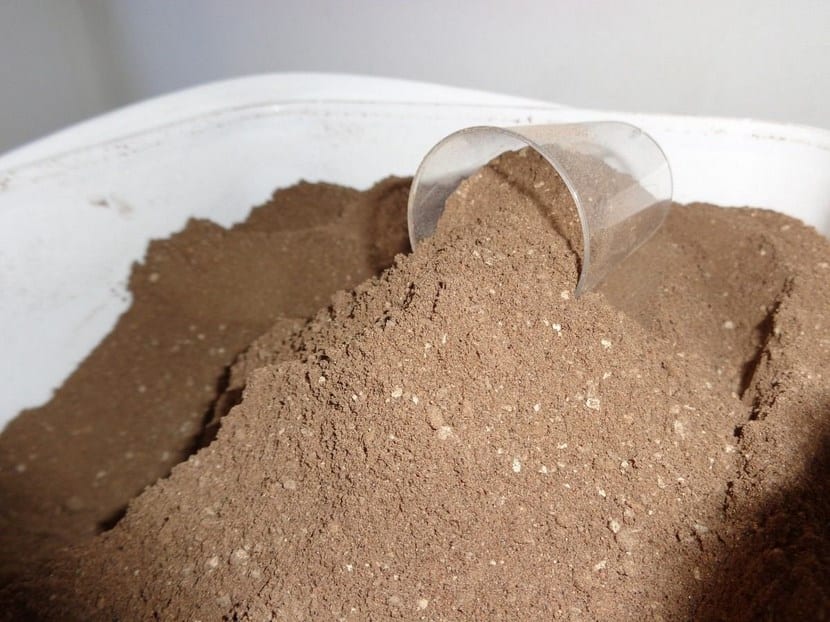
La Damiana It is a beautiful plant that can be had both in a pot and in the garden. It produces yellow flowers that, although they are small, are capable of brightening up the place where they are being cultivated. In addition, they attract beneficial insects, such as bees, which if we have a garden for example will be very helpful to pollinate 😉.
Its maintenance is not difficult, and as if that were not enough it has properties that can be interesting. Do you want to know what they are? Next I will tell you everything about her.
Origin and characteristics

Our protagonist is a native shrub from Mexico, Brazil, Bolivia and California whose scientific name is Turnera diffusaAlthough it is popularly known as damiana, grass of the shepherdess, grass of the deer, oreganillo, shepherd girl or male shirtbreaker. It grows to a height between 0,3 and 2 meters in height, and it is a very branching plant. the stems are straight, slightly reddish in color.
The leaves are simple, alternate, aromatic, oblong or rhombic-ovate, 1 to 2 cm long, glabrous on the upper surface and tomentose on the underside. The flowers are bisexual, solitary, axillary, 2-12mm long and yellow. The fruit is a capsule 4-5mm long, and contains small seeds.
What are their cares?

If you want to have a copy, we recommend that you provide it with the following care:
Location
You have to put your damiana plant outside, in full sun. Now, you can also have it indoors if you have a very bright room.
Earth
- Flower pot: it is not necessary to complicate much. It can grow well in universal growing medium, mixed or not with 30% perlite. You will find both substrates for sale in any nursery, garden store or online. You can also buy the first here and the second here.
- Garden: grows well in any type of soil, although it prefers those with good drainage. In the event that the soil of your land is very compact, make a planting hole of about 50cm x 50cm, and mix the soil with perlite in equal parts. So you won't have to worry about this.
Irrigation
The frequency of irrigation will vary depending on the climate and the season of the year in which we are, as well as if it is planted in the ground or in a pot. So, the ideal is to check the humidity of the soil before wateringWhile during the warm season it will be watered more often, in the autumn and winter months it will not need as much water.
To do this, you can do any of these things:
- Insert a thin wooden stick to the bottom: if it comes out practically clean, it will be necessary to water.
- Use a moisture meter digital: it will instantly tell you how humid that portion of earth that has come into contact with it has. To make it more useful, reinsert it, but this time further away or closer to the plant.
- Weigh the pot once watered and again after a few days- Wet soil weighs more than dry soil, so this difference can serve as a guide for when to water.
- Dig a bit in the soil around the plant: The surface of the earth dries very quickly, more than the inner layers, which often causes it to be watered more frequently than necessary. To avoid this, you have to dig a few inches around the plant to see how wet the soil really is.
Subscriber

Guano powder.
From early spring to late summer (it can also be done in autumn if the weather is mild or warm) it is advisable to fertilize it with ecological fertilizers once a month. Because of its rapid efficacy and high nutrient content, I recommend using guano, which is also easy to obtain. You can find it at nurseries, garden stores, or here. Of course, you must follow the instructions specified on the package to the letter, since although it is natural, it is so concentrated that if we go over the dose we can "burn" the plant.
Multiplication
The damiana multiplies by seeds in spring. The step by step to follow is as follows:
- First, you need to fill a pot or seedling tray (you can get it here) with universal growing substrate.
- Then, water thoroughly, ensuring that the substrate is well moistened.
- Next, place the seeds on the surface, and cover them with a thin layer of substrate.
- Finally, water again, this time with a sprayer, and place the pot or tray outside, in full sun.
Thus, the seeds will germinate in 2-3 weeks.
Pruning
It's not necesary. It is enough to remove the withered flowers.
Rusticity
It is a plant that does not resist cold or frost. Perhaps it can hold up to -1ºC once adult, but it is better not to expose it to low temperatures.
What properties does it have?

As we mentioned at the beginning, damiana is a shrub whose leaves have properties. In fact, it is stimulating, aphrodisiac, and tonic. It is used in infusion.
What do you think?